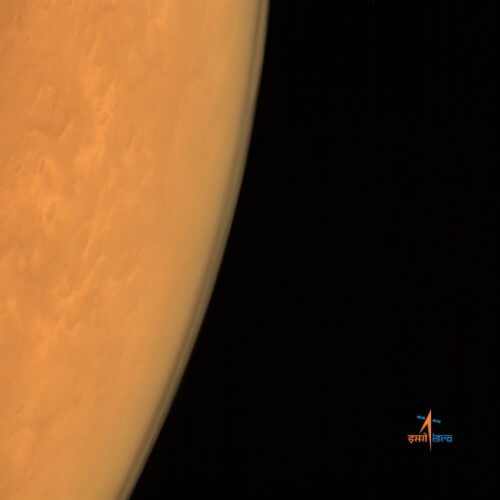The purpose of Mangalyaan or MOM (abbreviation Mars Orbiter Mission) is to study the Martian atmosphere, surface environment, morphology and mineralogy using an instrument set with a total weight of 15 kg containing 5 scientific instruments. It will also 'sniff' for methane, a possible marker of biological activity.

India's pioneering interplanetary spacecraft - Mangalyaan, or in English the Mars Orbiter Mission - MOM has transmitted new images of the Martian rim and its atmosphere against the blackness of space.
This image is only the second transmitted by the MIM spacecraft since its successful entry into Mars orbit via the historic insertion maneuver on September 23/24, 2014.
The Mars MOM was designed and developed by the Indian Space Research Organization (ISRO), which is actually the Indian Space Agency, which released the image on September 25, the day after MOM's arrival at the Red Planet.
The image was taken using the color camera Mars Color Camera (MCC) from an altitude of 8,449 km and Mars appears more orange than red in the image. The image has a spatial resolution of 439 meters per pixel and is centered around latitude 20.01 North and longitude 31.45 East.
MOM's goal is to study the Martian atmosphere, surface environment, morphology and mineralogy using a 15 kg instrument set containing 5 scientific instruments. It will also 'sniff' for methane, a possible marker of biological activity.
Following the successful maneuver of entering orbit, India became the newest member of the prestigious club of only four countries that have the ability to launch spacecraft that can successfully reach Mars following the Soviet Union and its successor Russia, the United States and the European Space Agency.
MOM now orbits Mars in an elliptical orbit whose closest point to Mars is at an altitude of 421.7 km and the farthest - 76,994 km. The inclination of the orbit relative to the equatorial plane of Mars is 150 degrees as planned. The mission cost 73 million dollars and its mission is expected to last at least six months.
MOM arrived on Mars in conjunction with NASA's Maven spacecraft which reached orbit around Mars on September 21 and may operate for ten years or more.
